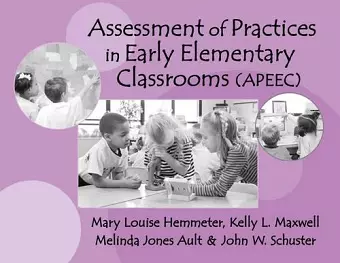Assessments of Practices in Early Elementary Classrooms
Mary Louise Hemmeter author Kelly L Maxwell author Melinda Jones Ault author John W Schuster author
Format:Paperback
Publisher:Teachers' College Press
Published:12th Jul '01
Currently unavailable, and unfortunately no date known when it will be back

APEEC is the first measurement scale designed to evaluate the use of developmentally appropriate practices in the early elementary classroom (K–3). Developed for classrooms serving both children with and without disabilities, the APEEC can be used by administrators and researchers to evaluate the degree of developmental appropriateness in inclusive and general education classrooms. It can also be used by teachers as a self-assessment tool. The book includes a carefully thought-out score sheet, which can be photocopied for use in rating classrooms.
Featuring straightforward language and an easy-to-follow format, APEEC is organized under three main categories:
1. Physical Environment—room arrangement, display of child products (e.g., artwork), classroom accessibility, health and safety
2. Instructional Context—use of materials and computers, monitoring child progress, teacher-child language, instructional methods, integration and breadth of subjects
3. Social Context—children’s role in decision-making, participation of children with disabilities, social skills, diversity, transitions between activities, and family involvement
The authors used a multi-step process to develop the APEEC, including a thorough review of the relevant literature (particularly the NAEYC guidelines and early childhood special education literature); an extensive review of the scale by practitioners, researchers, and board members of professional organizations and research journals; and field testing in 69 classrooms.
I am excited to see this new instrument for assessing learning environments in the early school years. Much too little attention has been given to examining the impact of these learning environments on children as they come to school and move into more formal school settings with academic expectations. This excellent new instrument should spur new research on the early school settings. It should also serve as an important guide for teachers as they assess their own practice. - Richard M. Clifford, Co-author of Early Childhood Environment Rating Scale and senior investigator at FPG Child Development Center ""The authors have addressed an important need by developing an assessment tool for use in observing and evaluating the developmental appropriateness of practices in the early primary grades. APEEC is a much-needed resource for the field."" - Sue Bredekamp, Council for Early Childhood Professional Recognition ""Schools can use the APEEC to evaluate the suitability of classrooms for placement of children with disabilities...The authors have done a service for the field."" - Mark Wolery, Peabody College, Vanderbilt University ""As a field researcher, I found the APEEC instrument to be very user-friendly. It is a comprehensive instrument that is easy to administer and yields a clear snapshot of the school and its primary program. The whole data-collecting process became an enjoyable educational experience."" - Donna Ison, Director of Professional Development for Central Kentucky Education Cooperative ""The APEEC has really helped me think about the set-up of my classroom and the structure of the class for both children with and without special needs. This is an excellent instrument!"" - Cindy Woolums, Classroom teacher ""As a principal, it is difficult to find a developmentally appropriate instrument that evaluates physical environment, curriculum, instruction, and social context. I feel the APEEC serves as the best instrument to evaluate these areas in the K-3 setting."" - Melissa Monts, Principal ""APEEC is a very useful and appropriate tool which was developed with much thought and thoroughly reviewed."" - Michelle Conley, Principal
ISBN: 9780807740613
Dimensions: 216mm x 279mm x 2mm
Weight: 68g
48 pages